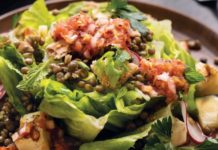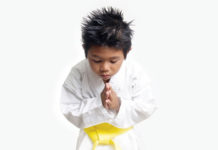
When most people hear the word vegan, the first thing that comes to mind is a diet free from animal products. But veganism is about more than what’s on your plate; it’s a lifestyle dedicated to environmental and cruelty-free principles, and that includes fashion.
What is vegan fashion?
Simply put, vegan fashion is fashion sans animal exploitation. It means no leather, no wool, no fur or skins, no silk, and no cashmere or angora (which comes from goats and rabbits, respectively).
This is because even if the creation of a textile didn’t result in loss of animal life, there are concerns over suffering, both of the animal and the environment, which is why diet is often just a starting point when it comes to veganism.
Perhaps not surprisingly, saying no to that sort of exploitation hardly means saying no to style. Gone are the days of plastic-like pleather and matted faux fur; more designers the world over are creating totally animal-free (and eco-friendly) lines of clothing and accessories.
“I think many people have a notion that vegan fashion is somehow different in that it isn’t as stylish,” says Crystal Brown, owner of The Grinning Goat, an all-vegan boutique in Calgary. “In fact, vegan fashion is often very stylish and on trend.”
Sustainability matters
However, it hasn’t always been so eco-friendly—faux fur has typically been made with plastics, and manufacturing requires harsh chemicals. In addition, research is showing that washing synthetic materials releases microplastic (tiny plastic particles) into the environment, polluting our oceans, animals, and even our drinking water. But in the past few years, a lot of that has been changing.
Many faux leathers that may once have called on petroleum to make fabrics for shoes, handbags, or belts are using bio-oils from organic cereal crops instead. Primaloft is making a biodegradable and recyclable down alternative. Several companies are making a leatherlike fabric out of pineapple leaves, orange peels, or grape skins—all byproducts of their respective farming industries.
Shoe soles manufactured from recycled tire rubber; cork purses; organic cotton, hemp, and linen: these materials are not only vegan but also more environmentally friendly than previous vegan alternatives.
Stella McCartney is making faux fur partly out of corn; several companies are experimenting with lab-grown leather and wool; while others are working toward protein-based silk made from engineered bacteria, no worms or spiders required. There are even companies using mushrooms to create faux skins.
Find vegan fashion
When it comes to eco-friendly, animal-free fashion, designers from around the world are creating dynamic new products, and that includes Canadian brands. Several Canadian vegan brands are making strides toward lifecycle management of their products (including repurposing materials after their use) and using innovative materials.
“Consumers increasingly want to align their wardrobes with their values, and as more cruelty-free and sustainable alternatives hit the marketplace, that choice becomes easier,” says P.J. Smith, director of fashion policy at the Humane Society of the United States. And by purchasing from brands that offer these choices, you can show companies that they can do well by doing good, he says.
These days, vegan fashion can be found anywhere. To locate it, check the label. Other things to look out for? Shoes may use glue made from animal bones. Non-leather bags or purses may have leather zipper pulls or tags. Cashmere, angora, and wool are sometimes present in knit garments such as sweaters, and down is a popular filling for winter coats. Watchbands and jewelry often contain leather, too.
If you can’t tell right off the bat, check the company website. Many brands post info online that disclose which of their products are vegan and what materials they use. If they don’t, ask. You’ll get your answer and simultaneously encourage them to broaden their offerings.
Ask companies that make vegan products what their materials are made from. For example, are they biodegradable? What happens at the end of their lifecycle? Do they contribute to microplastic pollution? Are they produced with harmful chemicals? After all, choosing vegan alternatives is about avoiding harm and suffering, and we need to examine the larger picture.
“It’s a movement,” Brown says, “And if you pay attention and ask questions, then the brands you buy from will start to do the same.”
Sustainable, vegan fashion is becoming more accessible as consumers learn the truth behind the industries and know they don’t need to use animals to be fashionable.
Great fabric options to shop for
Want cruelty-free fabrics that are kinder to the earth, too? Try these materials on for size:
- leather made from plants such as pineapples, orange skins, and mushrooms
- down alternatives made from materials such as recycled ocean plastic
- faux fur crafted from natural materials such as corn
- lab-synthesized silk instead of spider silk
- natural and organic materials such as cotton, hemp, and linen
- faux leathers made of natural materials such as grain instead of petroleum-based products
Where to find sustainable vegan fashion in Canada
Want to shop locally? Here are a few places where you can feel good about splurging on a new outfit:
- Nice Shoes, 3568 Fraser Street, Vancouver
- The Imperative, 1332 Queen Street West, Toronto
- The Grinning Goat, 101 – 323 17th Avenue SW, Calgary
Alisha McDarris is a vegan food and travel writer who loves to explore vegan scenes in new places. terradrift.com; Instagram: @terradrift
A version of this article was published in the January 2020 issue of alive Canada with the title “Vegan fashion is on trend.”




































